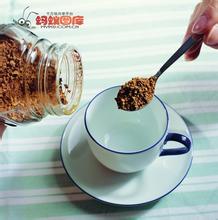Introduction to the characteristics of Grinding degree by conditional Flavor description treatment in Brazilian Coffee Bean planting area
Introduction of Brazilian Coffee beans
Including all coffee beans grown in Brazil, except for Santos, Brazilian beans are mostly "cheap and good" coffee. Can be used for mass production of comprehensive coffee beans, most of which are re-roasted. The main raw material of instant coffee is also Brazilian coffee beans. When the coffee bean germ is very fresh, it is artificially refined and naturally dried in the vulva for about 60-70 days, so that the sweetness of the pulp fully infiltrates into the bean. Features: coffee beans have a strong aroma, moderate bitterness, high texture acidity, soft overall taste, low acidity and endless aftertaste. The taste of Brazilian coffee has a low sour taste, with the sweet and bitter taste of coffee, the entrance is very smooth, but also with a hint of grass aroma, slightly bitter in the fragrance, smooth and smooth, with a pleasant aftertaste. There are no particular advantages for Brazilian coffee, but there are no obvious drawbacks. Brazilian coffee generally refers to coffee produced in Brazil with a mild and smooth taste, low acidity and moderate mellowness. There is a wide variety of Brazilian coffee, the vast majority of which are unwashed and sun-dried, classified according to the name of the state of origin and the port of transport. Brazil has 21 states and 17 states produce coffee, but four of them produce the largest, accounting for 98% of the country's total output. Brazilian coffee has a low sour taste, with the sweet and bitter taste of coffee, the entrance is very smooth, and with a hint of grass aroma, slightly bitter in the fragrance, smooth and smooth, the aftertaste can make people lively and pleasant Brazilian coffee generally refers to the coffee produced in Brazil. There is a wide variety of Brazilian coffee, the vast majority of which are unwashed and sun-dried, classified according to the name of the state of origin and the port of transport.
In the 19th century, coffee was grown almost all over the country, followed by a "coffee boom" that lasted nearly a century. The extensive cultivation of coffee has brought wealth and prosperity to Brazil. At the beginning of the 20th century, Brazil's coffee production accounted for more than 75% of the world's total output, thus winning the laudatory name of "coffee kingdom". Coffee is one of the important pillars of Brazil's national economy. There are 500000 coffee plantations, large and small, with a planting area of about 2.2 million hectares, a working population of more than 6 million, an annual output of about 2 million tons of coffee, and an annual export earnings of nearly 2 billion US dollars. In recent years, Brazilian coffee production and exports have declined due to changes in the export structure and the downturn in the international coffee market. Brazilians love coffee. In the 1960s, per capita annual coffee consumption in Brazil reached 5.8 kg. In the past two decades, with the emergence of other drinks, the per capita coffee consumption in Brazil is still more than 3 kilograms. In Brazil, all kinds of coffee houses can be seen everywhere in both urban and rural areas. People can drink hot coffee with rich fragrance almost anytime, anywhere.

Important Notice :
前街咖啡 FrontStreet Coffee has moved to new addredd:
FrontStreet Coffee Address: 315,Donghua East Road,GuangZhou
Tel:020 38364473
- Prev

90 + Honey Kiss Coffee Flavor description High-quality treatment characteristics of manor country Vietnam
Boutique 90 + Honey Kiss Coffee in 2009, this coffee was named after Nectar from Shakisso, meaning it has the same flavor as nectar from Ethiopia. Nekisse is characterized by a creamy and smooth taste, a strong berry sauce, and some batches even have a mixture of chamomile and a variety of tropical fruits. Although it was originally planted in Shakisso producing areas
- Next

Introduction to the Variety characteristics of Ramon Coffee Bean Flavor description in Colombia
Colombian boutique coffee beans introduce Colombian coffee varieties are mainly small grains of coffee. Plants are small trees or large shrubs, 5-8 m tall, usually much branched at base; old branches gray-white, nodes dilated, young branches glabrous, compressed. Leaves thinly leathery, ovate-lanceolate or lanceolate, 6-14 cm long and 3.5-5 cm wide, tip long acuminate, acuminate part 10-15 mm long, base cuneate
Related
- Detailed explanation of Jadeite planting Land in Panamanian Jadeite Manor introduction to the grading system of Jadeite competitive bidding, Red bid, Green bid and Rose Summer
- Story of Coffee planting in Brenka region of Costa Rica Stonehenge Manor anaerobic heavy honey treatment of flavor mouth
- What's on the barrel of Blue Mountain Coffee beans?
- Can American coffee also pull flowers? How to use hot American style to pull out a good-looking pattern?
- Can you make a cold extract with coffee beans? What is the right proportion for cold-extracted coffee formula?
- Indonesian PWN Gold Mandrine Coffee Origin Features Flavor How to Chong? Mandolin coffee is American.
- A brief introduction to the flavor characteristics of Brazilian yellow bourbon coffee beans
- What is the effect of different water quality on the flavor of cold-extracted coffee? What kind of water is best for brewing coffee?
- Why do you think of Rose Summer whenever you mention Panamanian coffee?
- Introduction to the characteristics of authentic blue mountain coffee bean producing areas? What is the CIB Coffee Authority in Jamaica?

